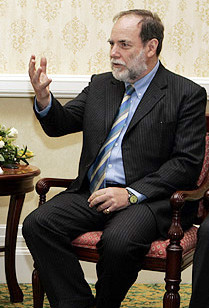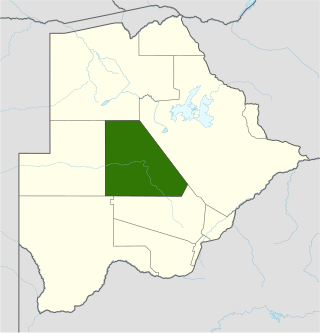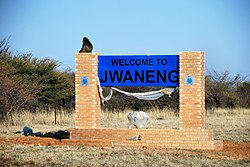
Botswana, officially the Republic of Botswana, is a landlocked country in Southern Africa. Botswana is topographically flat, with approximately 70 per cent of its territory being the Kalahari Desert. It is bordered by South Africa to the south and southeast, Namibia to the west and north, Zambia to the north and Zimbabwe to the northeast. Being a country of slightly over 2.4 million people and roughly the size of France, Botswana is one of the most sparsely populated countries in the world. It is essentially the nation-state of the Tswana people, who constitute 70 per cent of the population.

The economy of Botswana is currently one of the world's fastest growing economies, averaging about 5% per annum over the past decade. Growth in private sector employment averaged about 10% per annum during the first 30 years of the country's independence. After a period of stagnation at the turn of the 21st century, Botswana's economy registered strong levels of growth, with GDP growth exceeding 6–7% targets. Botswana has been praised by the African Development Bank for sustaining one of the world's longest economic booms. Economic growth since the late 1960s has been on par with some of Asia's largest economies. The government has consistently maintained budget surpluses and has extensive foreign-exchange reserves.

The De Beers Group is a South African-British corporation that specializes in the diamond industry, including mining, exploitation, retail, inscription, grading, trading and industrial diamond manufacturing. The company is active in open-pit, underground, large-scale alluvial and coastal mining. It operates in 35 countries with mining taking place in Botswana, Namibia, South Africa, and Canada. It also has an artisanal mining business, Gemfair, which operates in Sierra Leone.
Serowe is an urban village in Botswana's Central District. A trade and commercial centre, it is Botswana's third largest village. Serowe has played an important role in Botswana's history, as capital for the Bamangwato people in the early 20th century and as birthplace of several of Botswana's presidents. More recently it has undergone significant development as the town and as Botswana continues to grow.

Nicholas F. Oppenheimer is a South African billionaire businessman. He was formerly the chairman of De Beers diamond mining company and of its subsidiary, the Diamond Trading Company, and former deputy chairman of Anglo American. He is the third richest man in Africa.
The Orapa diamond mine is the world's largest diamond mine by area. The mine is located in Orapa, a town in the Central District of Botswana about 240 km (150 mi) west of the city of Francistown. Orapa is owned by Debswana, a partnership between the De Beers company and the government of Botswana. The mine was discovered on 1 March 1967, a year after Botswana's independence, by a team of De Beers geologists, including Manfred Marx, Jim Gibson and led by Dr. Gavin Lamont. It is the oldest of four mines operated by the company, and began operations in July 1971 and its first production was 1,438,168 carats (287,633.6 g). The revenue the mine generated is credited for transforming the Botswana economy, as it allowed the government to invest in critical social services and national infrastructure.

The Jwaneng diamond mine is the richest diamond mine in the world, and also the second largest in the world. It is nicknamed "the Prince of Mines", and is located in south-central Botswana about 170 kilometers (110 mi) southwest of the city of Gaborone.

Francistown is the second-largest city in Botswana, with a population of about 103,417 and 147,122 inhabitants for its agglomeration at the 2022 census. It is located in eastern Botswana, about 400 kilometres (250 mi) north-northeast from the capital, Gaborone. Francistown is located at the confluence of the Tati and Ntshe rivers, and near the Shashe River and 90 kilometres (56 mi) from the international border with Zimbabwe.
Debswana Diamond Company Limited, or simply Debswana, is a mining company located in Botswana, and is the world's leading producer of diamonds by value. Debswana operates four diamond mines in the eastern and central parts of Botswana, as well as a coal mine. Debswana is a joint venture between the government of Botswana and the South African diamond company De Beers; each party owns 50 percent of the company.
Lobatse is a town in south-eastern Botswana, 70 kilometres south of the capital Gaborone, situated in a valley running north towards Gaborone and close to the border with South Africa. Lobatse has a population of 29,772 as of 2022. The town is an administrative district, with a town council.

Southern is one of the districts of Botswana. The capital of Southern district is Kanye, home to the Bangwaketse and Barolong in Botswana. The Southern district is home to Botswana's second largest beef farmers where there are large privately owned ranges, and several government run beef ranges which provide agricultural support to the local farmers. Maize and sorghum, Botswana's staple crop, are also raised in the area. Southern district is where the third diamond mine of Botswana was found, which buoys Botswana's economic state of prosperity. It was the first district to house the capital city before being moved to Gaborone after independence.

Kanye is a village in southern Botswana, located 83 kilometres (52 mi) south-west of the capital, Gaborone. It is the administrative centre of the Southern District, and had a population of 48,028 as of the 2022 Population and Housing Census. This is an increase compared to the 45,196 of the 2011 census, making it the ninth-largest village in the country. Kanye is the traditional capital of the Ngwaketse tribe, who first settled in the area in the 1790s. The village is the longest continuously-occupied tribal capital in the country.

For the radio station, see CKGR-FM
Jwaneng Airport is an airport serving Jwaneng, a town in the Southern District of Botswana. It is owned by Debswana, which also owns the Jwaneng diamond mine. There is no scheduled airline service.

The mining industry of Botswana has dominated the national economy of Botswana since the 1970s, being a primary sector industry. Diamond has been the leading component of the mineral sector ever since production of gems started being extracted by the mining company Debswana. Most of Botswana's diamond production is of gem quality, resulting in the country's position as the world's leading producer of diamond by value. Copper, gold, nickel, coal and soda ash production also has held significant, though smaller, roles in the economy.
The geology of Botswana plays a significant part in the country's economy. The basement rocks of the Kaapvaal-Zimbabwe craton extend into Botswana whilst in the east and southeast, metamorphic rocks of Archaean age are dominant. A younger cover of Karoo rocks and post-Cretaceous Kalahari Group sediments conceal the western margins of these older rocks and largely conceal Proterozoic orogenic belts too. This younger stratum was laid down in the Kalahari Basin underlying large parts of the centre of the country. In the northwest of Botswana, more recent sediments overlie rocks of Meso- and Neoproterozoic age rocks, belonging probably to the Damara Belt.
The Mascom Top 8 Cup is a football cup competition in Botswana. It was created in 2012, and features the top eight finishers from the Botswana Premier League.
Botswana continued to address the COVID-19 pandemic in 2021, beginning its vaccination process through the importation of vaccines. On November 11, Botswana was the location of the first documented case of the SARS-CoV-2 Omicron variant. 2021 also saw the discovery of two diamonds in Botswana that exceeded 1000 carats, becoming the third and fourth largest diamonds ever discovered. In relations with its neighbouring countries, Botswana continued to address violence at the Botswana–Namibia border, and it entered into the conflict in Cabo Delgado in support of the government of Mozambique.











